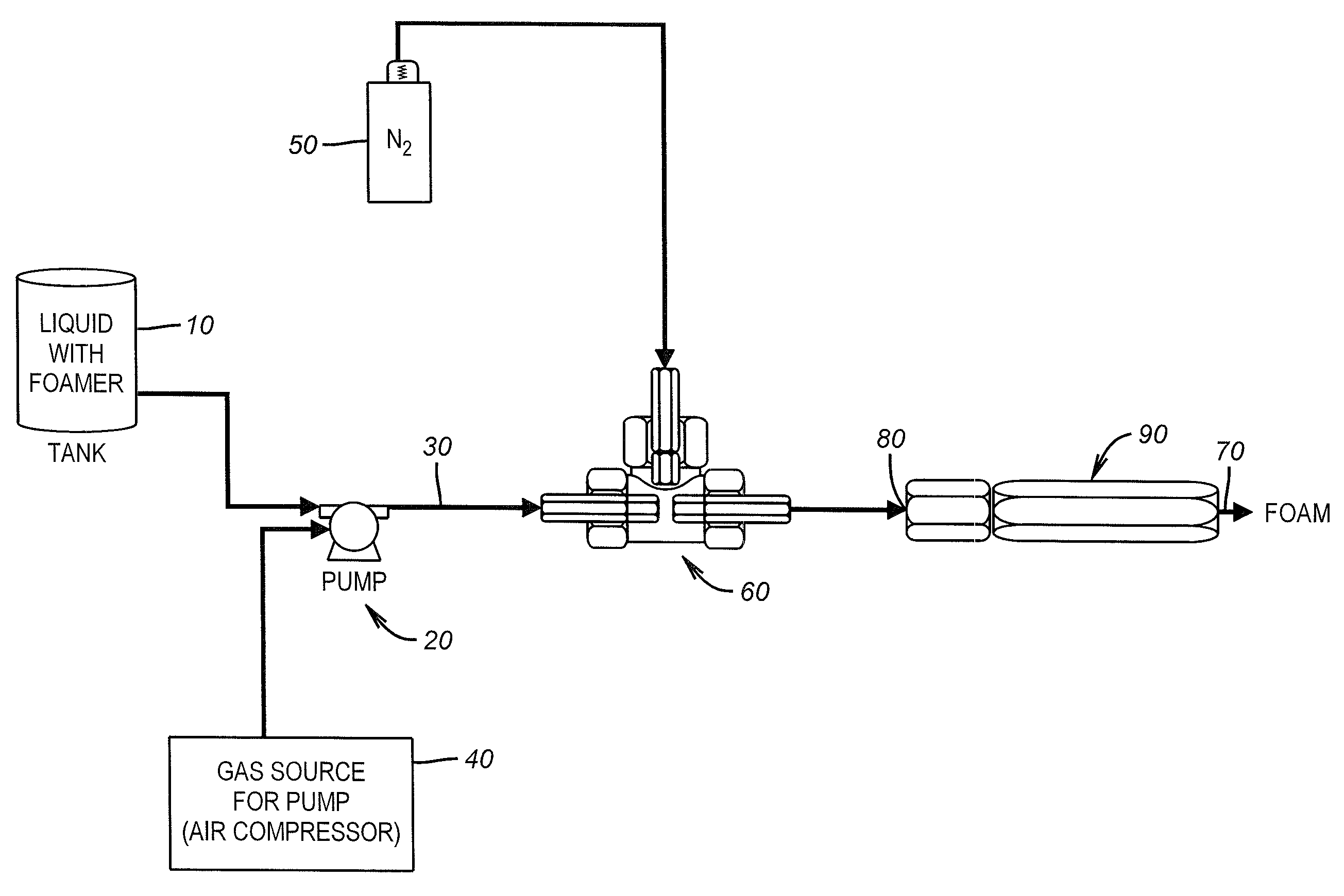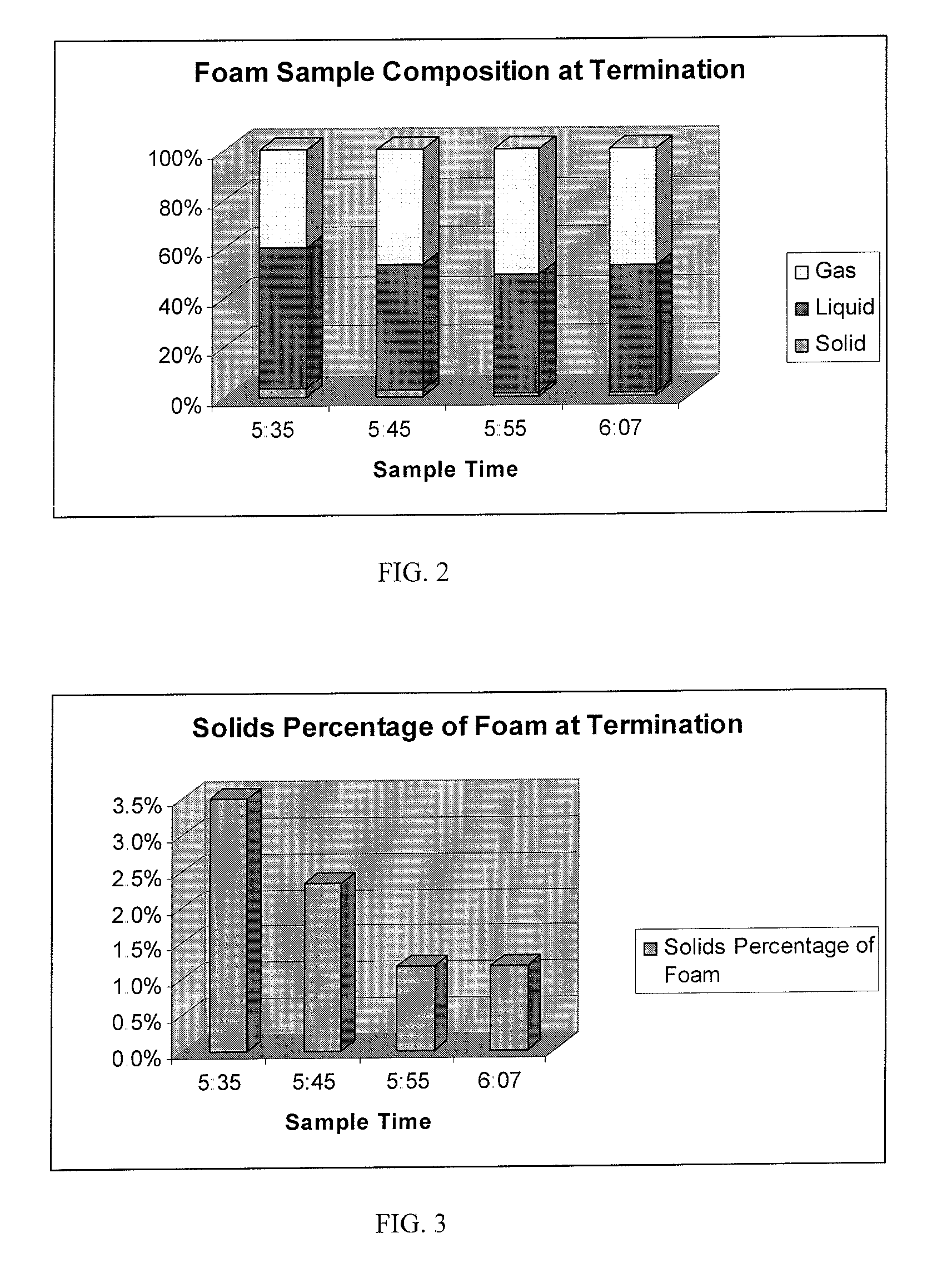Method of Treating Flow Conduits and Vessels with Foamed Composition
a flow conduit and composition technology, applied in the direction of cleaning hollow objects, chemistry apparatus and processes, borehole/well accessories, etc., can solve the problems of reducing the permeability of the subterranean formation, contaminant formation in equipment and flow conduits, and undesirable substances such as salt, scales, paraffins and asphaltenes, etc., to achieve low liquid volume and lower hydrostatic loading
- Summary
- Abstract
- Description
- Claims
- Application Information
AI Technical Summary
Benefits of technology
Problems solved by technology
Method used
Image
Examples
examples 1-4
[0052]To a foaming agent composed of 60% C14-C15 alkyl olefin sulfate, 18% ammonium alkyl ether sulfate, 10% monoalkyl ester and 12% isopropyl alcohol was added a treatment agent (WTA), water and nitrogen. The admixture was then foamed using the foaming apparatus set forth in FIG. 1. The foam quality of the foamed product was then determined. The results are set forth in Table I:
TABLE IFoamingN2 Agent,WTA,Pressure,FoamEx. No.AmountType, WTAWTAAmountWaterpsiQuality, %1120 mlsScale RemoverHCl, 28%140 mls12,000 mls40952120 mlsScale RemoverHCl, 28% 1 qt5 gallons609732%Scale InhibitorHEDP 6%Yes609542%Scale InhibitorHEDP12%Yes6097HEDP = (hydroxethylidenediphosphonic acid)
examples 5-9
[0053]The foamed treatment composition of Example 4 was introduced into an annulus at defined pressure. The residual concentration of treatment agent was measured in produced water. The results are set forth in Table II:
TABLE IICasingTubingInjectionTime toResidualEx.Pressure,Pressure,Pressure,Pump,Liquid Volume,AfterNo.psipsiNitrogen, psipsihrs:mingallonsOne Month518680181:1536NA6294080291:202931.82 ppm714075142:2042145.29 ppm 85080202:1538116.7 ppm920075254:004326.25 ppm
example 10
[0054]A corrosion inhibitor was prepared by mixing 65.70 ml of deionized water, 25 ml of coco-dimethyl benzyl quat, 8 ml of complex organic phosphate ester, free acid, 0.2 ml of thioglycolic acid and 1.10% of monoethanolamine. Approximately 1 gallon of the corrosion inhibitor was mixed with 1 gallon of water and was then mixed with 1.5% of amphoteric cocoamidopropyl betaine as foaming agent to render 60 gallons of foam.
PUM
| Property | Measurement | Unit |
|---|---|---|
| pressure | aaaaa | aaaaa |
| pressure | aaaaa | aaaaa |
| volume | aaaaa | aaaaa |
Abstract
Description
Claims
Application Information
 Login to View More
Login to View More - R&D
- Intellectual Property
- Life Sciences
- Materials
- Tech Scout
- Unparalleled Data Quality
- Higher Quality Content
- 60% Fewer Hallucinations
Browse by: Latest US Patents, China's latest patents, Technical Efficacy Thesaurus, Application Domain, Technology Topic, Popular Technical Reports.
© 2025 PatSnap. All rights reserved.Legal|Privacy policy|Modern Slavery Act Transparency Statement|Sitemap|About US| Contact US: help@patsnap.com



